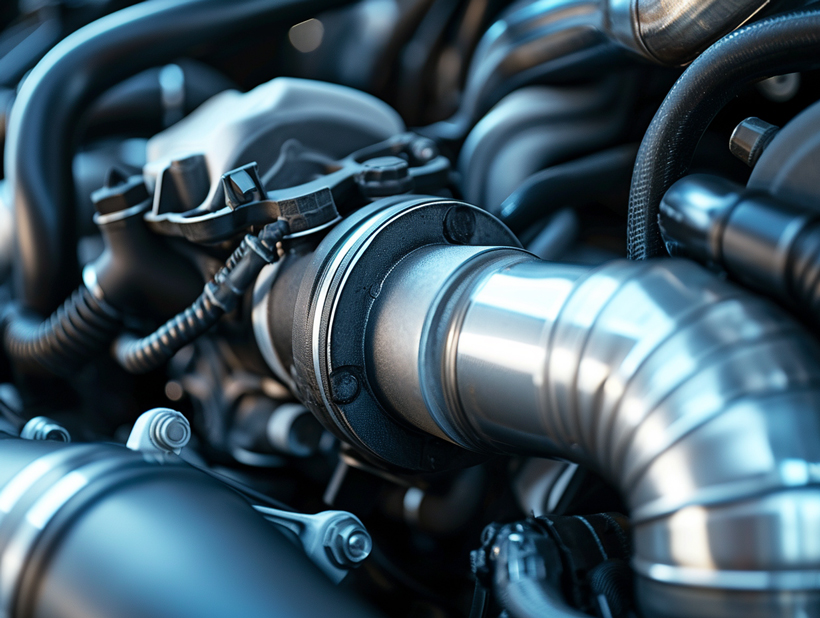Experiencing a tough time with your steering wheel can be a real pain, literally. Whether it’s a sudden stiffness or a whining noise that’s got you worried, power steering problems are not to be ignored. I’ve been there, and trust me, knowing what to look out for can save you a ton of hassle down the road.
As a seasoned driver and car enthusiast, I’ve learned that diagnosing steering system issues early is key to maintaining your vehicle’s health and your safety. In this article, I’ll guide you through the common signs of power steering problems and what they could mean for your ride.
Stay tuned as I break down the essentials of power steering diagnostics. I’ll help you understand the symptoms and potential fixes, so you can get back to smooth sailing‚Äîor should I say, steering‚Äîon the road.
Common Signs of Power Steering Problems
When it comes to keeping your car in top shape, being able to pinpoint power steering issues is crucial. I’ve dealt with my fair share of steering problems over the years, and there are some telltale signs that you should never ignore. Let’s delve into the symptoms that suggest your power steering might need some attention.

Difficulty Turning the Wheel
First and foremost, if your steering wheel starts to feel heavy or difficult to turn, it’s a clear indicator of a problem. This could happen suddenly or gradually, but either way, it’s a sign that your power steering system isn’t functioning correctly.
Whining or Squealing Noises
Another clue is the presence of whining or squealing noises when you turn the steering wheel. These sounds typically point to a power steering belt that’s either worn out or not tight enough. It’s essential to check these as soon as possible to avoid further damage.
Steering Wheel Vibrates
If you notice your steering wheel vibrating, especially as you’re starting the engine or idling, this could mean that the power steering belt is slipping ‚Äì a relatively quick fix if addressed early.
Fluid Leaks
Keep an eye out for fluid leaks under your car. Power steering fluid is vital for smooth steering, and any form of leakage can lead to performance issues. The fluid is usually a reddish or light brown color, so it’s quite noticeable on most surfaces.
Steering Feels Loose
Finally, if the steering in your car feels looser than usual, this could be a symptom of wear and tear in the power steering rack. Over time, this can lead to less control over your vehicle, which poses a significant safety risk.
Continual vigilance and awareness of these signs can save you from potential hazards on the road. Regular maintenance and prompt response to the first signs of trouble can prevent minor issues from escalating into major repairs. Regularly checking your power steering fluid levels and ensuring that your car’s maintenance checks are up to date are strong preventative measures. Driving should feel effortless, and if it doesn‚Äôt, it’s best to investigate – your safety might depend on it.
Sign 1: Sudden Stiffness in the Steering Wheel

If you’ve ever driven a car, you know that smooth steering is crucial for a comfortable and safe drive. Sudden stiffness in the steering wheel is a tell-tale sign of power steering problems. It often feels like the wheel isn’t responding as quickly as it should, making it harder to turn. This can happen unexpectedly and is a clear indicator that something’s not quite right with the steering system.
Experiencing a stiff steering wheel might initially seem like a minor annoyance, but it’s actually a serious concern that can affect driving safety. When the steering wheel is hard to turn, particularly at low speeds or while parking, it suggests that the power steering system isn’t performing optimally. One of the common culprits behind this issue is a drop in the power steering fluid level. Low fluid levels can cause the power steering pump to work harder, leading to increased effort when trying to steer.
Another possible cause of steering stiffness could be due to a faulty steering rack or issues with the power steering belt. The steering rack, a part of your steering mechanism, might be worn out or in need of lubrication. Similarly, a slipping or damaged belt can’t transmit the necessary force to the pump, leading to a lack of power assistance.
To properly diagnose the issue, I recommend checking the power steering fluid first. If it’s low, replenish it and look for potential leaks throughout the system. If the fluid level is fine, inspect the condition of the power steering belt and steering rack next.
When dealing with sudden steering wheel stiffness, don’t delay in seeking a professional mechanic’s assessment. Ignoring this sign can lead to further damage of power steering components and potentially result in a loss of vehicle control. Regular check-ups will help you catch such issues early on, ensuring a smooth and controlled driving experience.
Sign 2: Whining Noise When Turning
I’ve noticed that one of the most alarming sounds a driver can encounter is a whining noise coming from their car when they’re turning the steering wheel. If you’re hearing this peculiar sound, it’s a good indication that your power steering system could be under duress. Typically, this happens when the power steering fluid is low or has degraded, but it can also point to more serious issues within the system.
Upon hearing this sound, it’s essential to check the power steering fluid reservoir. If the fluid levels are indeed low, topping it off might temporarily alleviate the noise, but don’t stop there. A persistent whining, even after topping off the fluid, signifies that there might be a more significant problem like a leak or the need for a fluid flush.

In addition to checking the fluid, pay attention to when the noise occurs. Does it happen when the car starts, or is it only present when turning at certain speeds or angles? Pinpointing the conditions under which the noise intensifies can offer valuable clues. For instance, if the whining is most noticeable during low-speed turns, this could be a sign that the power steering pump itself is failing.
Another culprit behind the noise could be the power steering belt. If this belt is worn, loose, or improperly aligned, it won’t be able to efficiently transfer power from the engine to the steering pump. A quick visual inspection of the belt for any signs of wear, cracking, or glazing can save you from potential steering failure down the road.
Regular maintenance checks are key in preventing these issues before they escalate. It’s wise to include the power steering system in your routine vehicle check-ups. If the noise persists after your own inspections and fixes, turning to a certified mechanic is your best bet to ensure your vehicle remains reliable and safe on the road. They’re equipped with the expertise to diagnose the exact cause and perform the necessary repairs. Remember, proactive car care is always better than reactive car care.
Sign 3: Difficulty Turning the Wheel at Low Speeds
Encountering resistance when trying to turn the steering wheel at lower speeds is another telltale sign of a faltering power steering system. Normally, steering should be smooth and effortless, but when issues arise, turning at parking lot speeds or when maneuvering in tight spaces becomes more challenging.
When I first noticed this problem with my car, I realized it could stem from a variety of sources:
- Low Power Steering Fluid: Just like a whining noise, difficulty steering can be due to insufficient fluid in the power steering system. This critical fluid ensures smooth operation, and without enough of it, steering suffers.
- Power Steering Pump Failure: Should the pump responsible for circulating fluid through the system fail, steering will become laborious, especially at lower speeds where the assistance is most needed.
- Damaged Steering Rack: The steering rack is the heart of the system, and any damage to it can lead to stiff steering. It often wears out over time due to the stress of daily driving.
Addressing this issue promptly is crucial because the longer it’s left unchecked, the more damage can occur. Checking the power steering fluid level is a quick initial step I take to assess the situation. If it’s low, topping it off might offer a temporary fix, but it’s also important to check for possible leaks. A professional mechanic should take a closer look if the problem persists or if the fluid level is consistently low.
Regular maintenance can help stave off these issues, but sometimes, wear and tear are inevitable. Paying attention to how your vehicle handles, especially at low speeds, can provide early indications that your power steering system needs attention.
Sign 4: Steering Wheel Vibrations
When you’re experiencing vibrations in your steering wheel, especially when turning or accelerating, it’s a signal that shouldn’t be ignored. These vibrations hint at a potential issue within the power steering system. I’ve seen this in a myriad of vehicles and it’s often indicative of a problem that extends beyond mere inconvenience.
Various factors could be causing your steering wheel to quiver. One reason might be uneven tire pressure or wear which can throw off your vehicle’s balance and thus affect the steering. However, when it comes to power steering specific issues, you’re most likely looking at worn or loose power steering belts. Let me tell you, these belts are crucial for a smooth operation as they connect the power steering pump to the engine. If they’re not taut or in good condition, they can cause that unsettling vibration you feel in your hands.

Another possible culprit could be corroded steering fluid. Just like any other fluid in your car, the power steering fluid degrades over time and may become contaminated. When this happens, the fluid can’t provide the smooth and consistent flow needed for the power steering system to function optimally.
I’ve also encountered scenarios where a malfunctioning power steering pump is to blame. The pump is essentially the heart of the power steering system, facilitating the flow of fluid. If it’s failing, you‚Äôll definitely start feeling it through the wheel. Here’s what you can check:
- Ensure that power steering fluid is clean and at the correct level
- Inspect the power steering belts for any signs of wear or slack
- Check the condition of the tires and correct the tire pressure, if needed
Taking care of these components can make a big difference. Remember to keep up with regular maintenance and inspections. Spotting these signals early can save a lot of hassle and prevent further damage to your vehicle’s steering system. Trust me, steering wheel vibrations are a symptom you’ll want to get checked out as soon as possible.
Sign 5: Leaking Power Steering Fluid
When you start to notice a reddish or brownish fluid pooling under your vehicle, it might be a sign that you’re dealing with leaking power steering fluid. This issue should be addressed swiftly to avert potential damage to your power steering system. Leaks can happen for various reasons including worn seals, hose degradation, or even cracks in the reservoir. Identifying the source of the leak is key to remedying the problem.
During routine inspections, I always advise checking for wet or oily spots along the power steering lines and at the connections. The smallest drip can turn into a substantial leak over time, and catching these signs early can save you from an inconvenient breakdown or costly repair down the line.

Leaking fluid isn’t just a nuisance; it can lead to increased wear and tear on the system’s components. When fluid levels drop too low, the power steering pump could run dry and eventually fail, which would necessitate an expensive replacement. Here are a couple of steps I recommend taking if you suspect a leak in your power steering system:
- Inspect the Power Steering Hoses: Look for cracks, fraying, or loose fittings that might be the culprit behind the leak.
- Check the Seals and Gaskets: These components can wear out over time, leading to leaks at various connection points in the system.
If these components seem intact, the issue could be with the power steering pump itself or the reservoir that holds the fluid. It’s crucial not to overlook the possibility of a more severe problem, and if you’re unsure or the issue persists, have a professional mechanic take a look.
Regular maintenance and monitoring of your vehicle’s power steering fluid levels can prevent leaks from escalating. I’ve found that using the appropriate type and grade of steering fluid recommended by the vehicle’s manufacturer can also play a significant role in maintaining the integrity of the power steering system. Keep your car’s performance and safety in check by staying vigilant for signs like steering wheel vibrations and unexplained fluid beneath your car.
Remember, proactive care can extend the life of your power steering system and ensure smooth, responsive handling as you navigate the roads.
Potential Causes and Fixes for Power Steering Issues
When I face power steering problems, the first thing I do is pinpoint the root cause. Wear and tear is a common culprit, but it’s not always that simple. After all, a responsive steering system is critical for safe driving, so understanding what might go wrong is essential.
Pump damage is high on the list of potential issues. A failing power steering pump can lead to a lack of hydraulic pressure, which makes steering laborious. If you’re experiencing heavier steering or hearing whining noises, the pump may be to blame. Replacing or repairing it promptly restores proper function to your power steering.
Fluid contamination is another concern. Over time, the fluid can accumulate debris or simply degrade, which affects its ability to transfer pressure. I advise checking the fluid condition regularly and flushing the system if the fluid appears dirty or compromised. Remember, clean fluid can prevent many steering issues from arising.
In addition, a malfunctioning steering rack can manifest as stiffness in the wheel or odd sounds when turning. It’s a complex part, and usually, a professional mechanic should handle its repair or replacement. Sometimes, simple lubrication or tightening of connections can improve function, but often this part needs meticulous attention.

For those with electric power steering, electrical issues can’t be ignored. A blown fuse, a faulty sensor or wiring problems could lead to intermittent or total loss of power assistance. Diagnosing electrical components might require specialized equipment and expertise, but checking for obvious loose connections or damaged wires is a good starting point.
As always, different vehicles may exhibit unique symptoms and require specific solutions. Consulting your vehicle’s manual or seeking professional advice is advised, especially when you’re unsure about tackling steering system problems. Regular maintenance and staying attuned to how your car handles can catch issues early, often making fixes less complex. Knowing what to look for and how to address it empowers you to keep your car ‚Äî and steering ‚Äî running smoothly.
Cause 1: Low Power Steering Fluid
One of the primary causes of power steering issues that I’ve encountered during my time working on vehicles is low power steering fluid. This fluid is the lifeblood of the system, providing the necessary hydraulic pressure to assist in steering. When levels drop, you’ll likely hear a moan or groan when turning the wheel. The sound is a telltale sign that the fluid is struggling to circulate properly.
To check for low fluid levels, you should locate the reservoir and examine the dipstick or indicators. Fluid levels falling below the minimum mark clearly indicate it’s time for replenishment. Remember, different cars require specific types of power steering fluid so always refer to your owner’s manual before adding any.
Various issues can cause low fluid levels. A leak is often the culprit. Possible leak locations include:
- Hose connections
- Seals within the system
- The power steering pump itself
If you spot a leak, it’s crucial to address it quickly to avoid further complications. Driving with inadequate power steering fluid not only makes handling more difficult but can also lead to increased wear and tear on the entire system.
The process of refilling is straightforward, yet you must exercise caution to avoid introducing air into the system. Air bubbles in the fluid can lead to spongy steering response, which compromises your control over the vehicle. After refilling, it’s always a good practice to turn the steering from lock to lock a few times. This helps to bleed out any trapped air and ensures the system operates smoothly.
Regularly checking the power steering fluid, just as you would with oil or coolant, can help maintain the system’s integrity. Although some power steering systems are sealed and labeled as maintenance-free, they’re not immune to leaks and may still require attention over time. Keep an eye out for signs of moisture or puddling under the car after it’s been parked‚Äîthat’s often a giveaway that something’s amiss.
Cause 2: Damaged Power Steering Pump

When I start to hear a whining or a whirring noise under the hood, it’s often a sign that the power steering pump might be failing. This critical component is the heart of the power steering system, pressurizing and pushing the fluid through the hoses to aid in steering. When it’s damaged, steering can become labored and erratic, compromising my vehicle’s safety and responsiveness.
Inspecting the power steering pump for damage isn’t just prudent; it’s essential for maintaining control of my vehicle. A visual check can sometimes reveal fluid leakage or damage to the pump itself. The presence of metallic particles in the power steering fluid is another telltale sign of wear or damage, indicating internal components might be grinding against each other.
Monitoring for any irregular steering wheel behavior or changes in the steering performance helps pinpoint the issue. If I notice a decrease in steering power or a change in the steering wheel’s responsiveness, it may be time to have the power steering pump checked by a professional. Additionally, power steering fluid shouldn’t drop significantly between regular checks ‚Äì if it does, it could point to a leak in the pump.
Routine maintenance isn’t just crucial for longevity‚Äîit’s a proactive step in identifying issues before they become full-blown problems. I recommend having my power steering system inspected at each service interval, or immediately if I perceive any of the symptoms mentioned. Pumps can wear out due to regular use over time, and although a replacement can be on the costlier side, it pales in comparison to the potential risks and inconvenience of a total power steering system failure.
Cause 3: Faulty Power Steering Belt or Hose
When diagnosing power steering issues, don’t overlook the belts and hoses. The power steering belt connects the engine to the pump, creating the necessary pressure for the system to function smoothly. If this belt is frayed or broken, steering can become difficult and may cause the dreaded steering wheel squeal when you turn.
Likewise, power steering hoses are critical. They transport the fluid from the pump to the steering gear. A leak or blockage in these hoses can lead to a drop in fluid pressure, resulting in harder steering. Here’s what I’ve learned to watch out for:
- Check the tension of the power steering belt; it shouldn’t be too tight or too loose.
- Inspect hoses for signs of wear, such as cracks or bulges.
- Keep an eye out for wet or oily spots along the hoses that could indicate a leak.
But what if you can’t see any physical damage? Sometimes it’s an internal issue, like a clog or deterioration from within. That’s why it’s critical not to judge solely by appearances. A hose might look fine on the outside but could be causing issues on the inside due to contaminated fluid‚Äîanother reason why keeping up with regular fluid changes is essential.

As for the belt, also pay attention to alignment and pulley condition. Misalignment or a faulty pulley can quickly lead to belt damage. If you’re hearing a high-pitched screech, especially during cold starts, this is often a telltale sign of a belt problem.
To sum it up, it’s important to regularly check these components as part of your power steering system maintenance routine. Since I’ve been keeping close tabs on the condition of my car’s belts and hoses, I’ve managed to avoid unexpected steering troubles and ensure a smoother ride. Remember, catching these issues early can save you from a more complex and costly repair down the road.
Cause 4: Malfunctioning Steering Rack or Gearbox
When steering your car becomes more of an arm workout than a seamless action, it might be time to check for a malfunctioning steering rack or gearbox. This critical component of the steering system converts the rotational movement of your steering wheel into the linear motion needed to turn the wheels. Typically tucked away beneath your car, the steering rack endures constant use and, over time, can succumb to wear and tear.
Before delving into complex repairs, it’s wise to understand the common symptoms of a faulty steering rack or gearbox:
- Uneven tire wear: This is often a telltale sign that something is amiss with your steering system.
- Looseness in steering wheel: If your steering feels less precise than usual, it could indicate a problem with the steering rack.
- Clunking or knocking noises: Such sounds during steering might suggest worn gear teeth or a lack of proper lubrication.
Moreover, steering fluid plays a pivotal role in the smooth operation of the steering rack or gearbox. A decline in fluid quality or level can result in impaired steering response. Checking the steering fluid for signs of contamination is not only recommended, it’s crucial for maintaining the integrity of the entire system.
Another facet to keep an eye on is the condition of the bushings and seals within the steering rack. Worn bushings or damaged seals can lead to fluid leaks and can further exacerbate steering issues. Replacing these components can restore the tightness and accuracy you expect from your steering system.
An often underestimated aspect of the steering rack is its alignment with the rest of the steering mechanism. Proper alignment ensures your steering commands are accurately transmitted to the wheels. If there’s a misalignment, you’ll definitely feel it in the steering wheel, and it can pose a safety risk due to unpredictable vehicle handling.
Regular inspections can catch many of these issues before they escalate. If you’re not comfortable checking these components yourself, a trusted mechanic can perform a comprehensive evaluation. They’ll be able to tell you if it’s time for a repair or total replacement of the steering rack or gearbox. Remember, tackling steering problems early not only safeguards your driving experience but also helps in avoiding more costly repairs down the line.
